Abstract
The neuroactive peptides SCPB (small cardioactive peptide B) and FMRFamide (Phe-Met-Arg-Phe-NH2), both originally isolated from molluscs, have potent modulatory effects upon the production of patterned motor activity in identified neurons (e.g., B5 and B19) in the buccal ganglia of the snail Helisoma. Such patterned motor activity has previously been shown to underlie feeding behavior. Micromolar concentrations of SCPB initiate patterned motor activity in quiescent ganglia and increase the rate of activity in ganglia that are spontaneously active. Micromolar concentrations of FMRFamide inhibit patterned motor activity in Helisoma buccal ganglia, and 10 μM FMRFamide completely suppresses such activity. In addition, there are both anti-SCPB-and anti-FMRFamide-immunoreactive neurons in Helisoma buccal ganglia. Our results suggest that peptides may play a prominent role in the regulation of feeding behavior in Helisoma.
Keywords: Phe-Met-Arg-Phe-NH2, small cardioactive peptide B, molluscan feeding, snail
Full text
PDF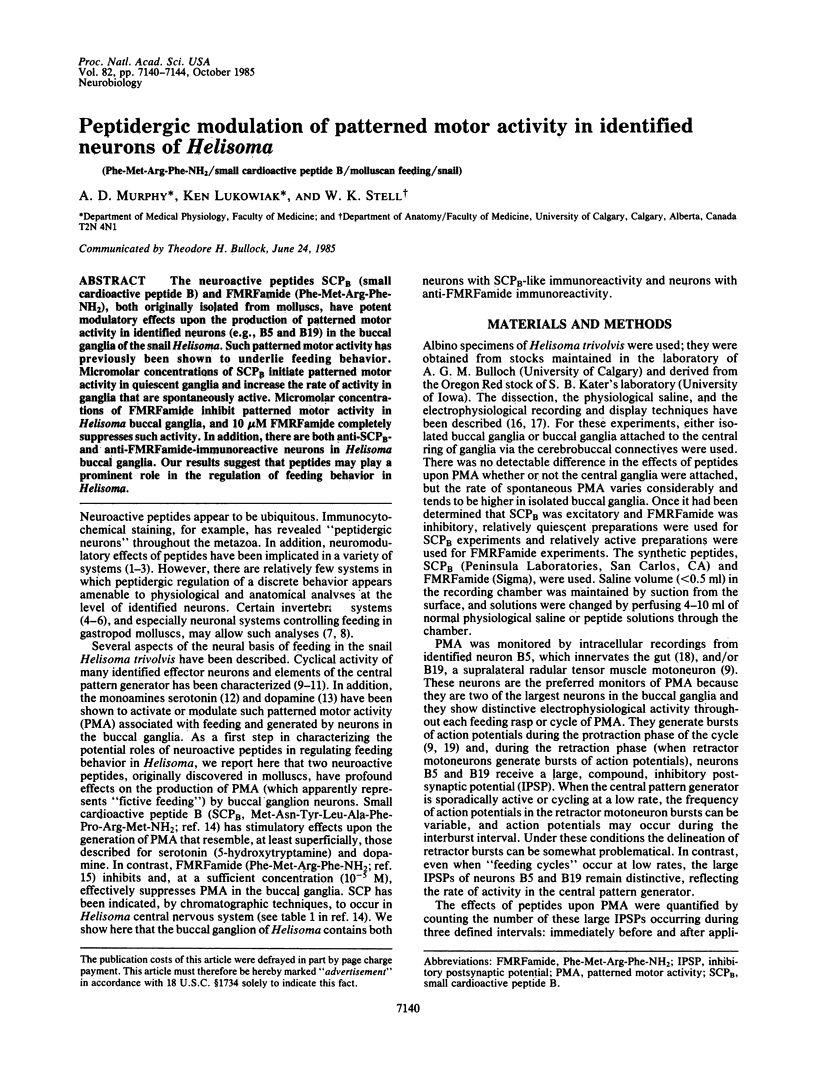
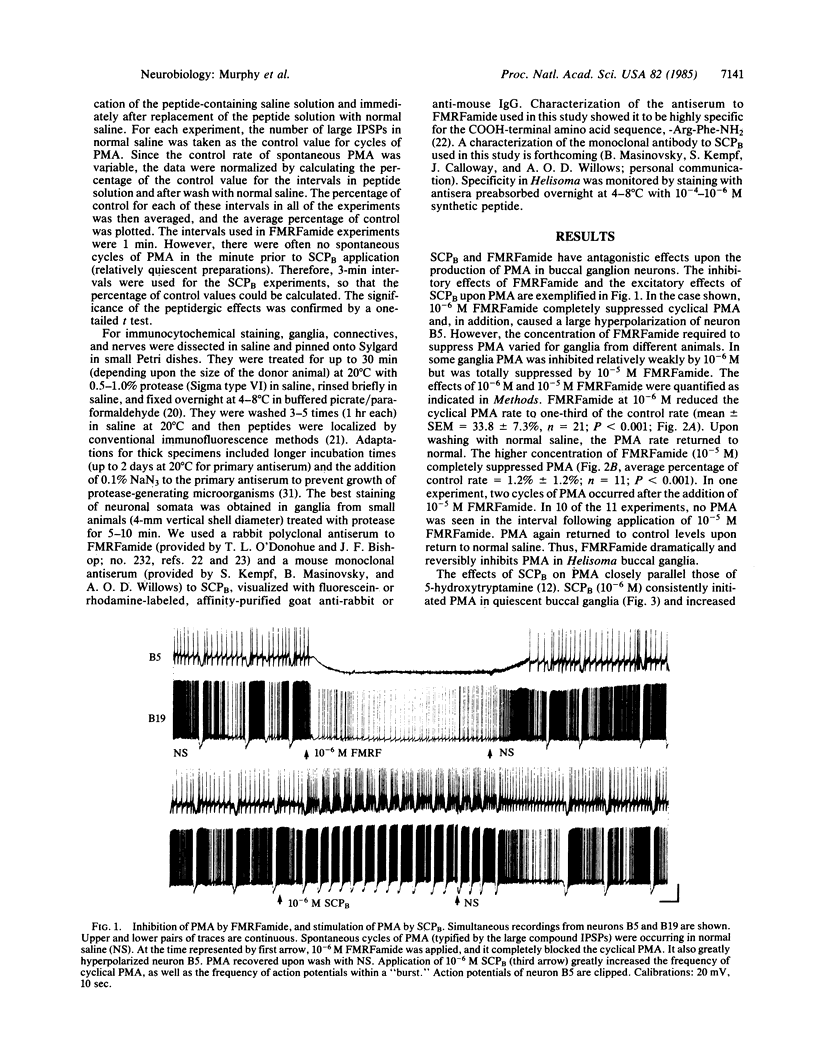
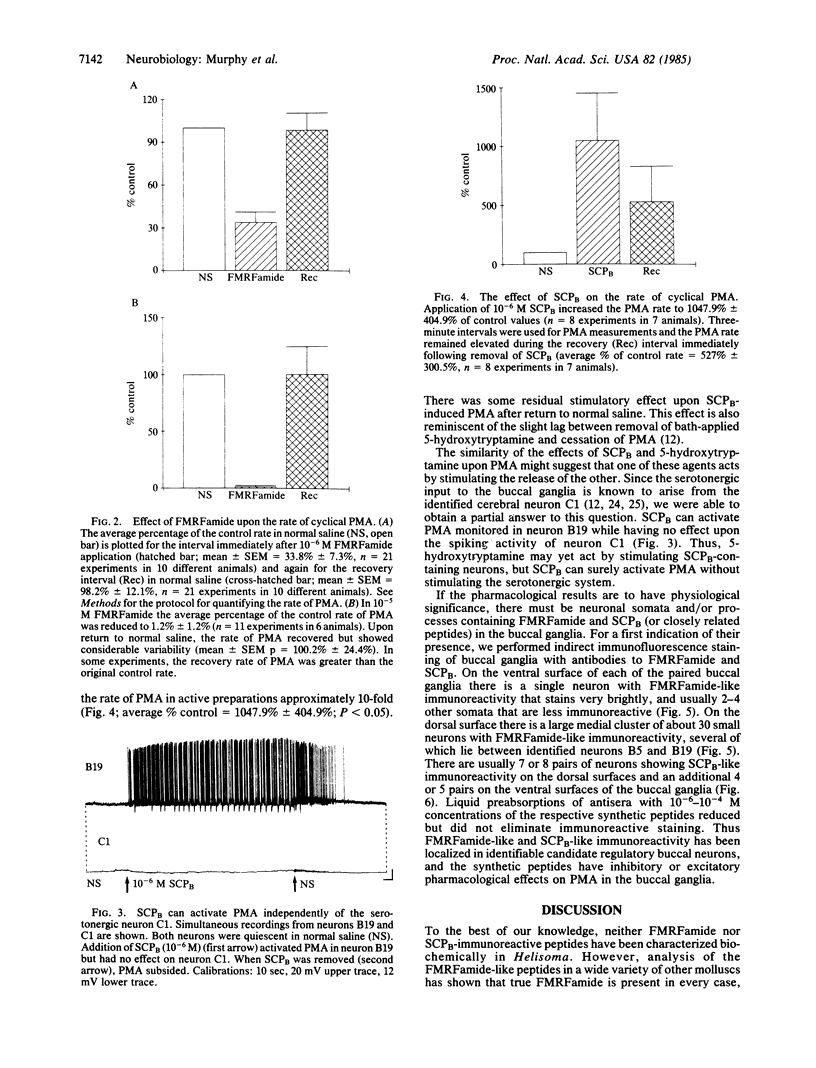
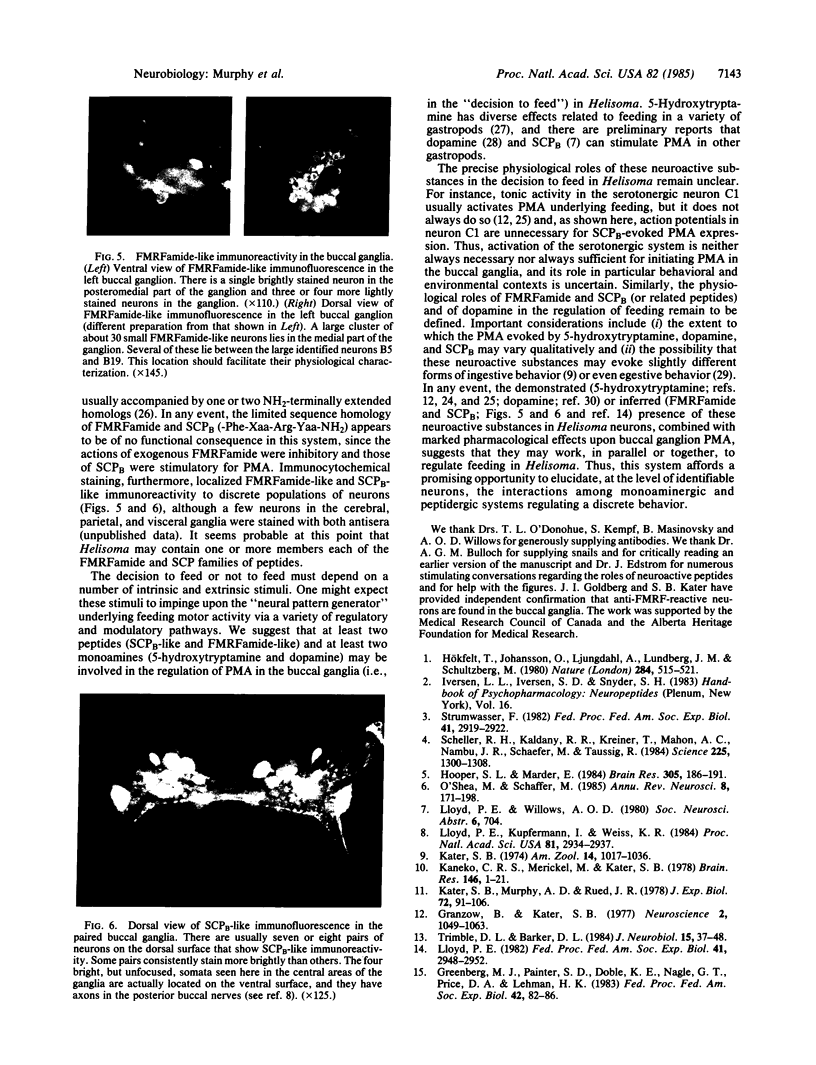
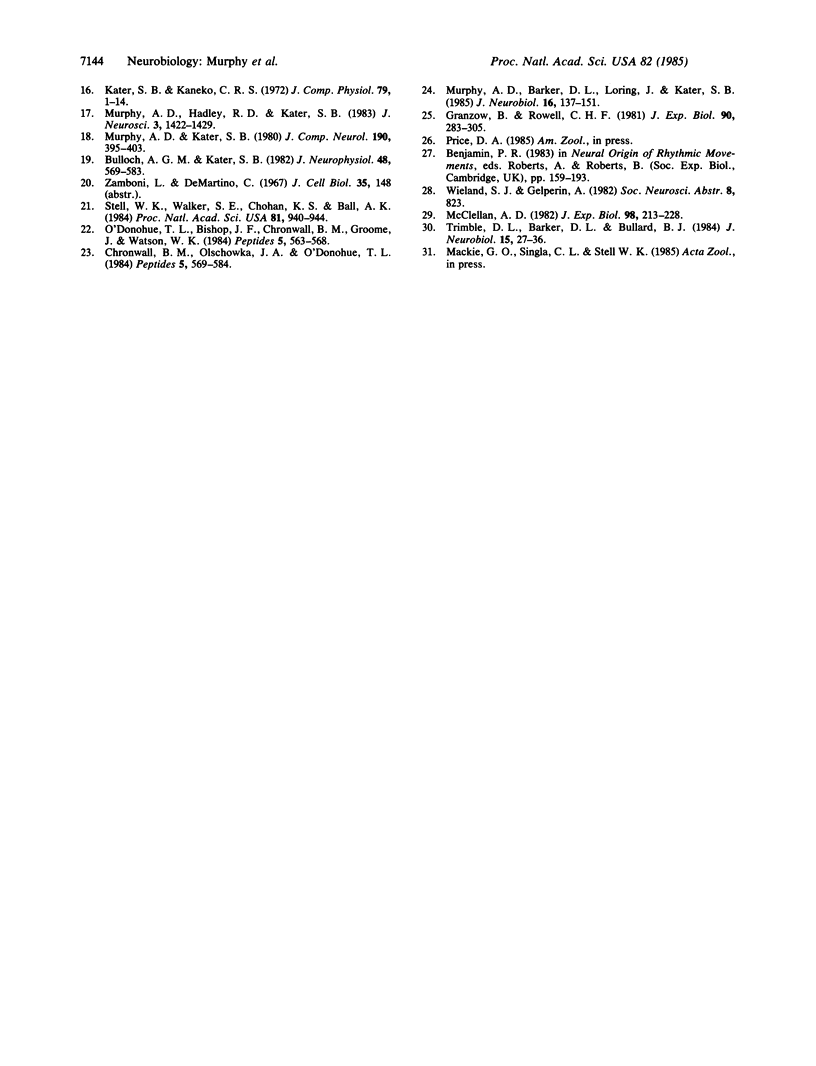
Images in this article
Selected References
These references are in PubMed. This may not be the complete list of references from this article.
- Benjamin P. R. Gastropod feeding: behavioural and neural analysis of a complex multicomponent system. Symp Soc Exp Biol. 1983;37:159–193. [PubMed] [Google Scholar]
- Bulloch A. G., Kater S. B. Neurite outgrowth and selection of new electrical connections by adult Helisoma neurons. J Neurophysiol. 1982 Aug;48(2):569–583. doi: 10.1152/jn.1982.48.2.569. [DOI] [PubMed] [Google Scholar]
- Chronwall B. M., Olschowka J. A., O'Donohue T. L. Histochemical localization of FMRFamide-like immunoreactivity in the rat brain. Peptides. 1984 May-Jun;5(3):569–584. doi: 10.1016/0196-9781(84)90088-3. [DOI] [PubMed] [Google Scholar]
- Greenberg M. J., Painter S. D., Doble K. E., Nagle G. T., Price D. A., Lehman H. K. The molluscan neurosecretory peptide FMRFamide: comparative pharmacology and relationship to the enkephalins. Fed Proc. 1983 Jan;42(1):82–86. [PubMed] [Google Scholar]
- Hooper S. L., Marder E. Modulation of a central pattern generator by two neuropeptides, proctolin and FMRFamide. Brain Res. 1984 Jul 2;305(1):186–191. doi: 10.1016/0006-8993(84)91138-7. [DOI] [PubMed] [Google Scholar]
- Hökfelt T., Johansson O., Ljungdahl A., Lundberg J. M., Schultzberg M. Peptidergic neurones. Nature. 1980 Apr 10;284(5756):515–521. doi: 10.1038/284515a0. [DOI] [PubMed] [Google Scholar]
- Kaneko C. R., Merickel M., Kater S. B. Centrally programmed feeding in Helisoma: identification and chracteristics of an electrically coupled premotor neuron network. Brain Res. 1978 May 5;146(1):1–21. doi: 10.1016/0006-8993(78)90214-7. [DOI] [PubMed] [Google Scholar]
- Kater S. B., Murphy A. D., Rued J. R. Control of the salivary glands of Helisoma by identified neurones. J Exp Biol. 1978 Feb;72:91–106. doi: 10.1242/jeb.72.1.91. [DOI] [PubMed] [Google Scholar]
- Lloyd P. E. Cardioactive neuropeptides in gastropods. Fed Proc. 1982 Nov;41(13):2948–2952. [PubMed] [Google Scholar]
- Lloyd P. E., Kupfermann I., Weiss K. R. Evidence for parallel actions of a molluscan neuropeptide and serotonin in mediating arousal in Aplysia. Proc Natl Acad Sci U S A. 1984 May;81(9):2934–2937. doi: 10.1073/pnas.81.9.2934. [DOI] [PMC free article] [PubMed] [Google Scholar]
- Murphy A. D., Barker D. L., Loring J. F., Kater S. B. Sprouting and functional regeneration of an identified serotonergic neuron following axotomy. J Neurobiol. 1985 Mar;16(2):137–151. doi: 10.1002/neu.480160206. [DOI] [PubMed] [Google Scholar]
- Murphy A. D., Hadley R. D., Kater S. B. Axotomy-induced parallel increases in electrical and dye coupling between identified neurons of Helisoma. J Neurosci. 1983 Jul;3(7):1422–1429. doi: 10.1523/JNEUROSCI.03-07-01422.1983. [DOI] [PMC free article] [PubMed] [Google Scholar]
- Murphy A. D., Kater S. B. Differential discrimination of appropriate pathways by regenerating identified neurons in Helisoma. J Comp Neurol. 1980 Mar 15;190(2):395–403. doi: 10.1002/cne.901900212. [DOI] [PubMed] [Google Scholar]
- O'Donohue T. L., Bishop J. F., Chronwall B. M., Groome J., Watson W. H., 3rd Characterization and distribution of FMRFamide immunoreactivity in the rat central nervous system. Peptides. 1984 May-Jun;5(3):563–568. doi: 10.1016/0196-9781(84)90087-1. [DOI] [PubMed] [Google Scholar]
- O'Shea M., Schaffer M. Neuropeptide function: the invertebrate contribution. Annu Rev Neurosci. 1985;8:171–198. doi: 10.1146/annurev.ne.08.030185.001131. [DOI] [PubMed] [Google Scholar]
- Scheller R. H., Kaldany R. R., Kreiner T., Mahon A. C., Nambu J. R., Schaefer M., Taussig R. Neuropeptides: mediators of behavior in Aplysia. Science. 1984 Sep 21;225(4668):1300–1308. doi: 10.1126/science.6474178. [DOI] [PubMed] [Google Scholar]
- Stell W. K., Walker S. E., Chohan K. S., Ball A. K. The goldfish nervus terminalis: a luteinizing hormone-releasing hormone and molluscan cardioexcitatory peptide immunoreactive olfactoretinal pathway. Proc Natl Acad Sci U S A. 1984 Feb;81(3):940–944. doi: 10.1073/pnas.81.3.940. [DOI] [PMC free article] [PubMed] [Google Scholar]
- Strumwasser F. Introduction: comparative neurobiology of peptidergic systems. Fed Proc. 1982 Nov;41(13):2919–2922. [PubMed] [Google Scholar]
- Trimble D. L., Barker D. L. Activation by dopamine of patterned motor output from the buccal ganglia of Helisoma trivolvis. J Neurobiol. 1984 Jan;15(1):37–48. doi: 10.1002/neu.480150105. [DOI] [PubMed] [Google Scholar]
- Trimble D. L., Barker D. L., Bullard B. J. Dopamine in a molluscan nervous system: synthesis and fluorescence histochemistry. J Neurobiol. 1984 Jan;15(1):27–36. doi: 10.1002/neu.480150104. [DOI] [PubMed] [Google Scholar]





